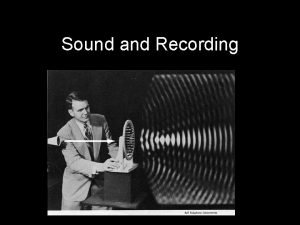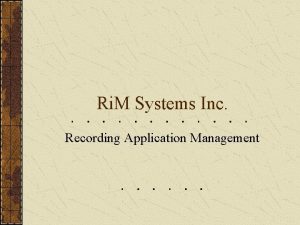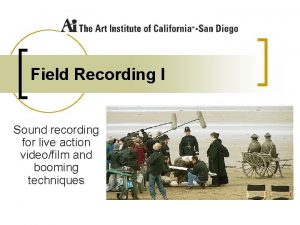Chapter 7 Recording The Music Industry Chapter 7



























- Slides: 27

Chapter 7 Recording & The Music Industry

Chapter 7 Recordings And The Music Industry: Copyright Battles, Format Wars Chapter Outline v. History v. Industry v. Controversies © 2008 The Mc. Graw-Hill Companies, Inc. All rights reserved

A Brief History of Recording Early Recording Technology Thomas Edison made the first recording in 1877, with a Phonograph ▪ A cylinder with grooves cut into it, a horn, and a hand crank. Victrola discs were introduced in 1906 by the Victor Company. ▪ They were easier to produce and less expensive than cylinders. © 2008 The Mc. Graw-Hill Companies, Inc. All rights reserved

A Brief History of Recording Early Recording Technology Ragtime and Tin Pan Alley made hits that sold well ▪ like Scott Joplin’s “Maple Leaf Rag” favorites like “Alexander’s Ragtime Band In 1914, music publishers joined together and formed ASCAP to fight for strong copyright laws. How ASCAP works © 2008 The Mc. Graw-Hill Companies, Inc. All rights reserved

A Brief History of Recording Enter Radio Commercial radio in the 1920 s ▪ Caused major changes in the recording industry. Radio spurred sales ▪ People wanted higher fidelity recordings of what was on the radio. Jazz recordings became hot, then big bands, then country music. ▪ Dance crazes would sell records. What are some dances that have been big over the years? © 2008 The Mc. Graw-Hill Companies, Inc. All rights reserved

A Brief History of Recording Rock and Roll By 1947, six large record companies controlled the popular music industry: ▪ Columbia, Victor, Decca, Capitol, MGM, and Mercury. Big labels pushed a mainstream music style epitomized by ▪ Bing Crosby’s crooning, Perry Como and Doris Day. © 2008 The Mc. Graw-Hill Companies, Inc. All rights reserved

A Brief History of Recording In 1954, Memphis disc jockey and label owner Sam Phillips released “That’s All Right Mama” ▪ Elvis Presley moved to RCA where he recorded several hits including “Don’t Be Cruel” and “Hound Dog. ” ▪ Defined rock music until the 1960 s when the Beatles and other British groups like the Rolling Stones entered the picture. © 2008 The Mc. Graw-Hill Companies, Inc. All rights reserved

A Brief History of Recording Presley borrowed many of his songs from the black community. Proved how successful black music could be with a white artist on the album cover, a practice known as covering. ▪ He added a white hillbilly sound to rhythm and blues and gospel, © 2008 The Mc. Graw-Hill Companies, Inc. All rights reserved

A Brief History of Recording Chuck Berry and Little Richard ▪ Two African Americans who did manage to break through with their own rock and roll acts. In 1959, on “the day the music died, ” ▪ Three of rock and roll’s biggest stars, Buddy Holly, Richie Valens, and the Big Bopper ▪ Killed in a plane crash, © 2008 The Mc. Graw-Hill Companies, Inc. All rights reserved

A Brief History of Recording Rap and Hip-Hop Rap is speaking in rhythm over drum beats. Hip-hop, is the backing music for rap, ▪ Often composed of a collage of ‘samples’ from other songs. Hip-hop also refers to the culture of rap. Rap originated in the early 1970 s in the boroughs of New York City, especially the Bronx. © 2008 The Mc. Graw-Hill Companies, Inc. All rights reserved

A Brief History of Recording Rap and Hip-Hop The 1 st commercial rap record “Rapper’s Delight” was recorded in 1979 by The Sugar Hill Gang. In the 1990 s, rivalries between east and west coast factions of rappers culminated in the murders of Tupac Shakur and Notorious B. I. G. © 2008 The Mc. Graw-Hill Companies, Inc. All rights reserved

A Brief History of Recording The Format Wars Intensify Sony’s Walkman portable audio cassette player, introduced in 1979, ▪ Became wildly successful as joggers and commuters listened to their favorite songs while moving about Did any in here ever have a Walkman? © 2008 The Mc. Graw-Hill Companies, Inc. All rights reserved

A Brief History of Recording CDs (compact discs), plastic discs with digitally encoded music that is read by lasers, were introduced in 1983. Format revitalized the industry ▪ Music lovers replaced collections of analog vinyl and cassette tape ▪ CD’s had better sound quality and greater durability of the new high-tech medium. ▪ Minidiscs, a smaller version of the CD, appeared in the late 1990 s. ▪ Anyone ever have minidiscs? ▪ Why didn’t the public embrace them? © 2008 The Mc. Graw-Hill Companies, Inc. All rights reserved

A Brief History of Recording Music Downloading In the 1990 s, listeners began copying CDs onto their computers. In 1999, a college student named Shawn Fanning developed Napster, the first successful free file-sharing program. The music industry shut down the free version of Napster through legal action, but soon several competitors were developed. © 2008 The Mc. Graw-Hill Companies, Inc. All rights reserved

A Brief History of Recording Music Downloading By 2001, file-sharing and inexpensive CD recorders, or burners, were seriously cutting into music industry profits. Napster returned in 2004 as a legal, low cost music downloading service. © 2008 The Mc. Graw-Hill Companies, Inc. All rights reserved

A Brief History of Recording Music Downloading In 2006 the head of the Recording Industry Association of America declared ▪ Unauthorized song swapping had been “contained. ” ▪ Do you think this is true today? The industry cannot sue every single infringer, but reasoned ▪ “If the industry makes enough waves in enough countries through legal actions, court cases could have a serious deterrent effect. ”

Understanding Today’s Recording Industry The Major Labels: Global Goliaths Five major corporations, Warner, EMI, Sony, Universal, and Bertelsmann, ▪ Collect around 80 percent of recording industry revenues each year. Until the 1980 s, part of a major label’s business was to develop new talent. ▪ Today, artists who don’t sell fast are dropped or not given adequate promotion. In the 90 s, majors signed multi-million dollar deals with superstars ▪ Including Michael Jackson, Mariah Carey, Motley Crue and Prince. ▪ Most of these projects were artistic and financial disappointments and drained support from developing acts. © 2008 The Mc. Graw-Hill Companies, Inc. All rights reserved

Understanding Today’s Recording Industry Top Selling Albums of All Time © 2008 The Mc. Graw-Hill Companies, Inc. All rights reserved

Understanding Today’s Recording Industry Independents: Developing Talent Independent labels are not owned by one of the four majors. ▪ Industry practice is for the majors to acquire successful independents ▪ What are some independent labels that are now under major labels Many independents become successful by handling specialized material not profitable for bigger companies, ▪ Such as jazz, classical, religious, or rap. Priority Records became the largest U. S. independent ▪ Distributing records such as Ice-T’s “Cop Killer” which was too controversial for Warner Brothers. What Major is priority records associated with © 2008 The Mc. Graw-Hill Companies, Inc. All rights reserved

Understanding Today’s Recording Industry The Players A&R (artist and repertoire) ▪ Executives discover and develop the groups and performers. Producers ▪ Oversee the making of a master tape from start to finish, including mixing and editing. Most artists spend years performing but never get a chance to record for a label. ▪ Overnight success of television programs such as “American Idol” are sensational exceptions. Some artists become very wealthy but there is also a history of artists, such as Chuck Berry, Mary Wells, TLC ▪ Who were exploited or robbed by managers, promoters and record companies. © 2008 The Mc. Graw-Hill Companies, Inc. All rights reserved

Understanding Today’s Recording Industry Royalties and Performance Rights Organizations There are two types of royalties: 1. Recording-artist royalties 2. Songwriter/publisher royalties Recording artists earn royalties from the sale of their recordings on CDs, tapes, vinyl, and legal downloads. Recording artists don’t earn royalties when their recordings are played on radio or TV. Songwriters and publishers, do earn royalties on radio play and other public performances, as well as on recording sales. © 2008 The Mc. Graw-Hill Companies, Inc. All rights reserved

Understanding Today’s Recording Industry Promotion Promoters ▪ Concentrate on getting a cut from the album played on radio stations. ▪ They focus on reporting stations whose playlists determine, along with sales, a song’s placement on the charts in Billboard magazine. In 1991, Soundscan, ▪ A point-of-sale computer system records the bar codes scanned at thousands of stores, began reporting record sales to Billboard. Promoters arrange press coverage, lobby for awards, feed tidbits to gossip-hungry Web sites, try to place music videos on MTV, BET, CMT and VH 1, ▪ try to get songs on movie and television soundtracks, and in television commercials. © 2008 The Mc. Graw-Hill Companies, Inc. All rights reserved

Understanding Today’s Recording Industry Distribution and Sales Recordings are distributed & sold through a variety of methods, ▪ Online retailers & outlets such as music stores, bookstores, electronic stores, discount stores, movie stores, and music clubs. Online distribution can produce a higher profit margin than traditional retailing Labels ▪ Save the cost of packaging, ▪ Don’t have to worry about losing sales because a title is sold out, ▪ Do not have to absorb the costs of unsold overstock.

Understanding Today’s Recording Industry The Audience Consumers are less loyal to individual groups than in the past. Some critics say major labels encourage the fickleness of young audiences ▪ Because they can sign young artists to cheap contracts and make big profits with a single album. ▪ What are some of your favorite artists © 2008 The Mc. Graw-Hill Companies, Inc. All rights reserved

Controversies The Effects Throughout the 1990 s ▪ Sadomasochistic lyrics, gansta rap, and shock rock were linked to youthful crime and decadence. Several documented cases where teens committed suicide after listening to recordings such as Ozzy Osbourne’s “Suicide Solution” and Judas Priest’s Stained Class album, ▪ Although no court of law has ever found an artist responsible. © 2008 The Mc. Graw-Hill Companies, Inc. All rights reserved

Controversies Censorship In 1990, the music industry adopted parental warning labels ▪ After pressure by The Parent’s Music Resource Center (PMRC). Discount chain Wal-Mart is the largest seller of pop music in the country ▪ But will not carry CDs with parental advisories on them. © 2008 The Mc. Graw-Hill Companies, Inc. All rights reserved

Controversies Censorship Most labels will airbrush CD covers, change lyrics or delete entire songs to avoid such bans. In 2003, Clear Channel Communications, the largest owner of radio stations in the U. S. , ▪ Stopped playing the music of the Dixie Chicks after a member of the group criticized President George Bush. © 2008 The Mc. Graw-Hill Companies, Inc. All rights reserved
 Music music music
Music music music Music recording
Music recording Japanese music industry
Japanese music industry Classical vs romantic music
Classical vs romantic music Music appreciation elements of music
Music appreciation elements of music Music that employs electronic music
Music that employs electronic music Pamulinawen instrument used
Pamulinawen instrument used Hát kết hợp bộ gõ cơ thể
Hát kết hợp bộ gõ cơ thể Frameset trong html5
Frameset trong html5 Bổ thể
Bổ thể Tỉ lệ cơ thể trẻ em
Tỉ lệ cơ thể trẻ em Chó sói
Chó sói Glasgow thang điểm
Glasgow thang điểm Hát lên người ơi
Hát lên người ơi Các môn thể thao bắt đầu bằng tiếng nhảy
Các môn thể thao bắt đầu bằng tiếng nhảy Thế nào là hệ số cao nhất
Thế nào là hệ số cao nhất Các châu lục và đại dương trên thế giới
Các châu lục và đại dương trên thế giới Cong thức tính động năng
Cong thức tính động năng Trời xanh đây là của chúng ta thể thơ
Trời xanh đây là của chúng ta thể thơ Cách giải mật thư tọa độ
Cách giải mật thư tọa độ 101012 bằng
101012 bằng độ dài liên kết
độ dài liên kết Các châu lục và đại dương trên thế giới
Các châu lục và đại dương trên thế giới Thơ thất ngôn tứ tuyệt đường luật
Thơ thất ngôn tứ tuyệt đường luật Quá trình desamine hóa có thể tạo ra
Quá trình desamine hóa có thể tạo ra Một số thể thơ truyền thống
Một số thể thơ truyền thống Cái miệng nó xinh thế chỉ nói điều hay thôi
Cái miệng nó xinh thế chỉ nói điều hay thôi Vẽ hình chiếu vuông góc của vật thể sau
Vẽ hình chiếu vuông góc của vật thể sau



















































